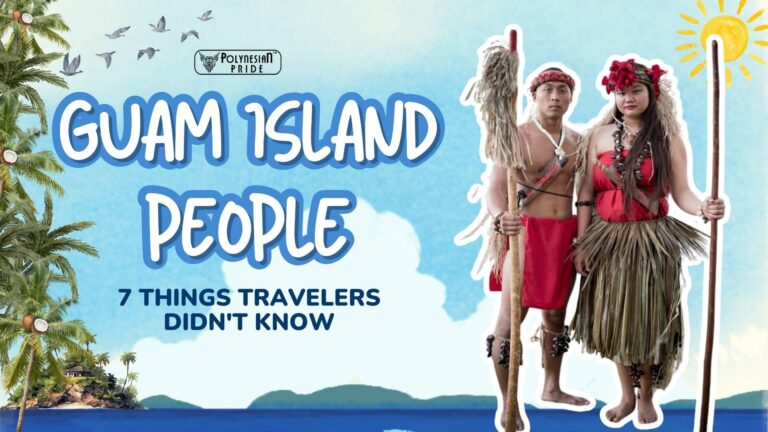The Maori People Haka: A Cultural Legacy of Strength & Pride

Imagine the thunderous rhythm of chanting echoing through the air, accompanied by the synchronized stomping of feet and the intense expressions of warriors. This is the Maori people haka, a powerful tradition that transcends its origins to become a symbol of cultural identity, resilience, and pride.
Rooted in Maori traditions, the Maori people’s haka is more than just a performance; it’s a powerful expression of mana (prestige), whakapapa (genealogy), and the deep connection to ancestral heritage and spiritual beliefs. From the rugby fields of New Zealand to international events, the haka has captivated audiences worldwide, leaving an indelible mark on contemporary society.
In this article, we’ll explore the captivating world of the haka, its diverse forms, enduring legacy, and the secrets behind its power.
I. Understanding the Origins and Purpose of the Haka

The haka’s roots lie deep within the rich traditions of the Maori people, tracing back to their ancestral homeland in Polynesia. As warriors, the Māori relied on strength, skill, and intimidation to protect their territories and establish dominance. The haka served as a crucial weapon in their arsenal, a potent tool for both physical and psychological warfare. Its purpose extended far beyond intimidation, however, and encompassed a range of social and cultural functions.
The haka was performed for various reasons, including welcoming guests, honoring special occasions, and celebrating victories. It was also used to communicate and reinforce tribal identities, connect with ancestral spirits, and seek their protection in times of conflict. The haka’s dynamic and expressive nature made it the perfect vehicle to convey emotions such as pride, strength, and unity, making it an integral part of Maori culture and society.
II. Types of Haka: A Diverse Expression of Maori Culture
The haka’s evolution has diversified the art form, resulting in distinct variations and forms used for specific purposes. Here are some of the main types of haka:
War Haka (Peruperu)
The most well-known form, the war haka (peruperu), was traditionally performed before battle to intimidate opponents. Fierce expressions, vigorous movements, and rhythmic chanting combined to create a powerful presence. Today, New Zealand’s armed forces and sports teams still use the war haka to inspire courage and unity.
Ceremonial Haka
Different types of ceremonial haka are performed to mark significant life events and occasions like weddings, funerals (haka tangi), and other cultural ceremonies. Each has its own unique purpose and meaning.
- Haka Powhiri: This haka welcomes guests to a marae, a sacred Māori meeting place. It acknowledges and honors guests, conveying hospitality and respect.
- Haka Taparahi (Wedding Haka): Performed at weddings, the haka taparahi celebrates and blesses the newlyweds. It’s a joyous haka that symbolizes the strength of their love.
- Haka tangi (funeral haka): Haka tangi is performed at funerals to honor the deceased and express grief and sorrow. This powerful and emotional haka is also a way for the living to pay their respects and let go of their loved ones.
Social Haka
Social hakas are more relaxed and playful than other forms and are performed for entertainment and social gatherings. Often accompanied by singing and hand gestures, they bring people together and create a sense of community. Social hakas are used in schools, festivals, and events to showcase Maori culture and encourage participation.

III. What makes a Haka?
To truly understand the power and impact of the haka, it is essential to break down its elements and examine how they work together to create a mesmerizing performance.
Rhythmic Chanting (Haka Waiata)
The haka begins with a rhythmic chant, haka waiata, led by one or two leaders. This chanting serves as a foundation for the rest of the performance and sets the pace and tone for the dancers to follow.
The words of the haka are often a mix of Maori language and traditional chants, with each word carrying deep meaning and significance. Loud, forceful grunts punctuate the haka’s chanting, intensifying the overall performance.
Vigorous Foot-Stamping (Haka Tapahi)
The next element of the haka is the vigorous foot-stamping, known as haka tapahi. This action symbolizes the warriors’ connection to the land and their strength and stability on the battlefield. The synchronized stomping produces a powerful thumping sound that adds rhythm and energy to the performance.
Expressive Body Movements (Haka Peruperu)

The most iconic aspect of the haka is the expressive body movements, known as haka peruperu. These movements include fierce facial expressions, chest slapping, arm gestures, and tongue protrusions. Each movement has meaning and significance, with the overall effect being a display of strength, power, and intimidation.
Facial Expressions (Haka Ngenge)
The facial expressions used in the haka are crucial in conveying its message and impact. The intense staring eyes, puffed-out cheeks, and protruding tongue represent the warrior’s readiness for battle, as well as their defiance and determination to overcome any challenge.
Use of Weapons (Haka Patu)
In some hakas, weapons such as patu (short clubs) or taiaha (long-handled weapons) may be incorporated into the performance. These weapons symbolize the warriors’ skills and prowess in battle and reinforce the haka’s intimidating nature. But haka wouldn’t be complete without its traditional attire that reflects tribal identity and spiritual power, making it an essential part of New Zealand traditional clothing.
IV. The Haka’s Cultural Significance: Beyond a Dance

To fully understand the haka, it is essential to recognize that it is more than just a dance; it is a cultural expression that embodies the values, beliefs, and traditions of the Maori people. The haka reflects the Māori’s deep connection to their land, ancestors, and spiritual beliefs. Here are some core values and concepts that the haka represents:
Mana (Prestige, Power)
Mana is an essential concept in Māori culture and refers to a person’s authority, status, and power. The haka embodies this concept by elevating the performers to a position of prestige and strength, both physically and spiritually.
Whakapapa (Genealogy, Ancestral Connections)
Whakapapa is the Māori term for genealogy and refers to a person’s lineage and ancestral connections. The haka often references ancestors, reinforcing the performers’ deep connection to their heritage and identity.
Kaitiakitanga (Guardianship of the Land)
Kaitiakitanga is the Māori principle of protecting and preserving the land for future generations. The haka reflects this value by acknowledging and honoring the role of Māori as guardians of the land.
Manaakitanga (Hospitality, Respect for Others)
Manaakitanga is the practice of showing hospitality and respect to others. The haka embodies manaakitanga (hospitality) by welcoming and honoring guests and fostering community and unity among performers and spectators.
Through these values and concepts, the Maori people haka is a powerful vehicle for cultural expression, identity affirmation, and community cohesion.

V. Maori People Haka in Modern Times
The haka has evolved and adapted over time, and its impact has extended far beyond the battlefields of its origins. Here are some examples of how the haka is seen in modern times:
Rugby and Sports
One of the most well-known associations with the haka is its use by the New Zealand All Blacks rugby team before their matches. The haka has become synonymous with the team, and its performance has become a pre-game ritual that inspires players and unites players.
The All Blacks’ haka, Ka Mate, was composed in the 19th century by a Māori warrior, Te Rauparaha, to celebrate his escape from a rival tribe. The team’s performance has become an iconic symbol of New Zealand’s national pride and cultural identity. It is often imitated and respected by other teams around the world.

Explore the cultural roots and symbolic beauty of Maori Traditional Clothing – a timeless expression of Māori identity and pride.
The Haka’s Global Impact and Contemporary Adaptations
The haka has transcended its origins to become a powerful symbol recognized and respected internationally. It has graced the stages of major events like the Olympics and World Cups, captivating audiences with its raw energy and cultural significance. This global influence extends beyond sporting arenas, finding its way into popular culture through movies, TV shows, and music videos. The haka’s impact is further amplified by its adoption by other cultures, inspiring similar dances performed by sports teams and organizations in countries like Tonga, Fiji, and Samoa.
But the haka isn’t just a captivating performance; it’s a dynamic tradition that adapts to contemporary issues. In 2016, a group of Māori activists used the haka as a powerful tool for resistance, performing it to protest the construction of a housing development on sacred land. This act exemplifies the haka’s ability to be used for social and political commentary, becoming a voice for indigenous rights and environmental causes. These contemporary adaptations showcase the haka’s enduring legacy as a symbol of resilience, strength, and cultural pride, continuing to resonate with people across the globe.
The Enduring Legacy of the Haka: A Symbol of Resilience and Pride

As we have seen throughout this exploration, the haka holds a deep and enduring significance for the Maori people. It is a powerful reminder of their ancestral heritage, cultural identity, and values. The haka’s impact extends far beyond the battlefield; it is a symbol of resilience and pride that continues to resonate with people across the globe.
In today’s world, where cultural diversity and understanding are increasingly important, the haka is a shining example of the power of tradition and identity. It brings people together, celebrates diversity, and promotes cross-cultural understanding. As long as the haka lives on, so too will the legacy of the Māori people and their enduring spirit.
Conclusion
The haka, a powerful Māori posture dance, transcends its warrior origins. Evolving into a symbol of resilience, pride, and unity, it captivates audiences worldwide. From ceremonial gatherings to global stages, the haka embodies core values like mana (prestige) and whakapapa (genealogy). It serves as a bridge between generations, fostering community and cultural identity. As its legacy endures, the haka reminds us of tradition’s importance and artistic expression’s power. May Maori people haka continue to echo through the ages, carrying with it the stories, struggles, triumphs, and spirit of the Maori people for generations to come. Ka mate! Ka mate! Ka ora! Ka ora! (I die! I die! I live! I live!).
Frequently Asked Questions
What does haka mean to Maori people?
By Te Puia. Traditionally, haka was a customary way to welcome visiting tribes, but it also served to invigorate warriors as they headed into battle. It was a show of physical prowess but also an embodiment of cultural pride, strength, and unity.
What is the spiritual significance of the haka?
Haka is a way of expressing a range of emotions, from joy and celebration to grief and anger. It is a physical and vocal display of strength, power, and unity. It is also a way of connecting with ancestors and spiritual beliefs.
What countries do the haka?
The famous Haka, performed by the New Zealand and Samoa national teams, has become one of the most viral images of the World Cup. It’s a challenging and intimidating dance for the opponents.
Are Māori people Polynesian?
The Indigenous Māori people constitute the largest Polynesian population, followed by Samoans, Native Hawaiians, Tahitians, Tongans and Cook Islands Māori.

I am a cultural historian and editor with over 10 years of research into pre-contact Polynesian history, the Lapita migration, and oral traditions. Share the excitement of my latest publications.
My contact:
Email: [email protected]
Tel: +64 21 456 7890






